Julie Mehretu | Ensemble
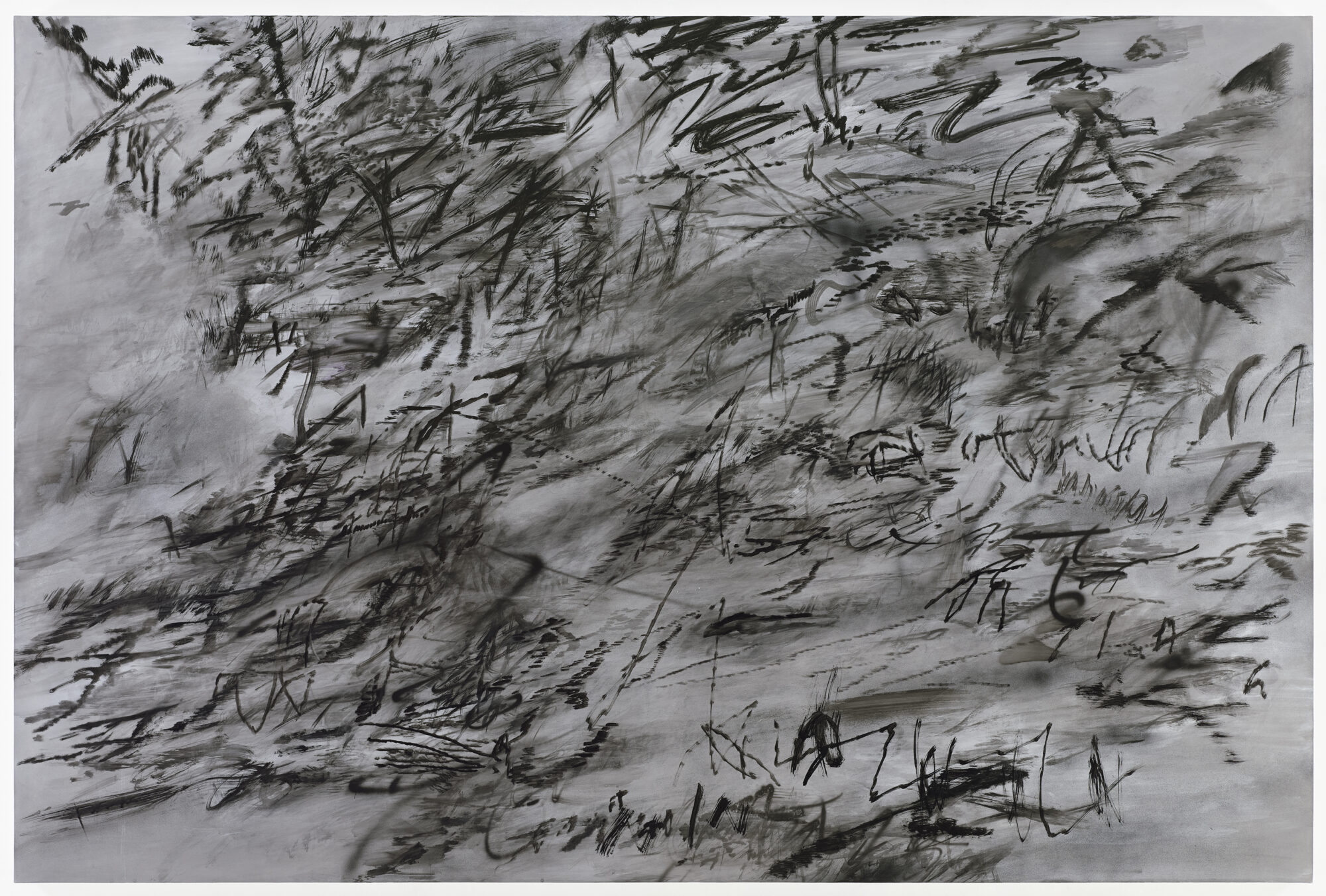 In the wake of ongoing contemplation over the harrowing events of the atrocities in the Gaza Strip, Julie Mehretu’s exhibition at Palazzo Grassi serves as a profound testament to the transformative power of art in grappling with the complexities of the surrounding reality.
In the wake of ongoing contemplation over the harrowing events of the atrocities in the Gaza Strip, Julie Mehretu’s exhibition at Palazzo Grassi serves as a profound testament to the transformative power of art in grappling with the complexities of the surrounding reality.
Covering twenty-five years of activity and presented as a free and non-chronological path, Julie Mehretu’s exhibition “Ensemble” is on view through January 6th, 2025, at Palazzo Grassi in Venice. Mehretu, born in 1970 in Addis Ababa, Ethiopia, and now based in New York, anchors her practice in abstraction, drawing inspiration from history, geography, social struggles, and revolutionary movements. Her work embodies a synthesis of these influences, echoing the collective spirit that defines the exhibition. Mehretu’s closest artist friends, including Nairy Baghramian, Huma Bhabha, Tacita Dean, David Hammons, Robin Coste Lewis, Paul Pfeiffer, and Jessica Rankin, contribute to this dialogue, sharing an intense affinity and fostering a relationship of exchange and collaboration. Caroline Bourgeois, the exhibition’s curator, notes that like Mehretu, each of these artists has been shaped by the transfers they have undergone or chosen.
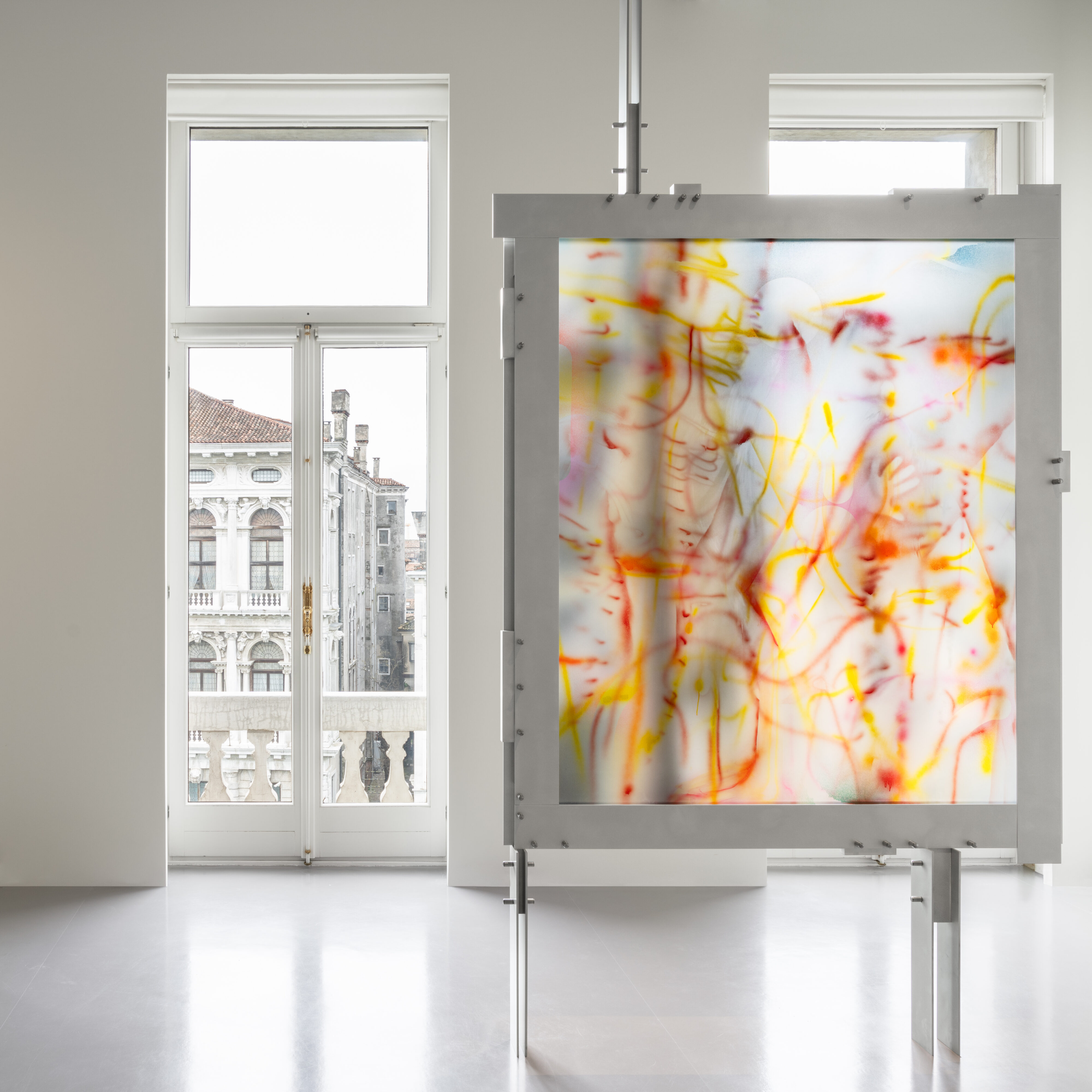 From the very beginning, everything starts with the drawing. For Mehretu, a drawing has a capacity to act: it can grow, build, play a role. At the turn of the twentieth century, the artist began to produce very large canvases, on which a technical pen records the geometric arrangement of architectural drawings from different sources in the form of straight lines and regular curves. On these frames of imaginary, composite cities, which are ‘sealed’ with a layer of transparent acrylic, Julie Mehretu lays tumultuous, ‘atmospheric’ strokes in ink and acrylic evoking changing and agitated skies or swarms of small figures joined to form shifting ensembles. In these works, the entanglement and fusion of different spaces confuse the viewer’s reference points. The canvas takes on the appearance of what Mehretu describes as a map of stories that does not correspond to any place. It is more an expanding landscape or one caught in a transitory moment, imitating the dynamic movement of a maelström. Some of these works bear the mark of Julie Mehretu’s time in Berlin, a city with a great mixture of layers and urban typologies. Graphic signs, broad and iridescent, translate a sound energy that becomes almost palpable. The artist here investigates architecture as space but also of power spaces, of power ideas linked to politics.
From the very beginning, everything starts with the drawing. For Mehretu, a drawing has a capacity to act: it can grow, build, play a role. At the turn of the twentieth century, the artist began to produce very large canvases, on which a technical pen records the geometric arrangement of architectural drawings from different sources in the form of straight lines and regular curves. On these frames of imaginary, composite cities, which are ‘sealed’ with a layer of transparent acrylic, Julie Mehretu lays tumultuous, ‘atmospheric’ strokes in ink and acrylic evoking changing and agitated skies or swarms of small figures joined to form shifting ensembles. In these works, the entanglement and fusion of different spaces confuse the viewer’s reference points. The canvas takes on the appearance of what Mehretu describes as a map of stories that does not correspond to any place. It is more an expanding landscape or one caught in a transitory moment, imitating the dynamic movement of a maelström. Some of these works bear the mark of Julie Mehretu’s time in Berlin, a city with a great mixture of layers and urban typologies. Graphic signs, broad and iridescent, translate a sound energy that becomes almost palpable. The artist here investigates architecture as space but also of power spaces, of power ideas linked to politics.
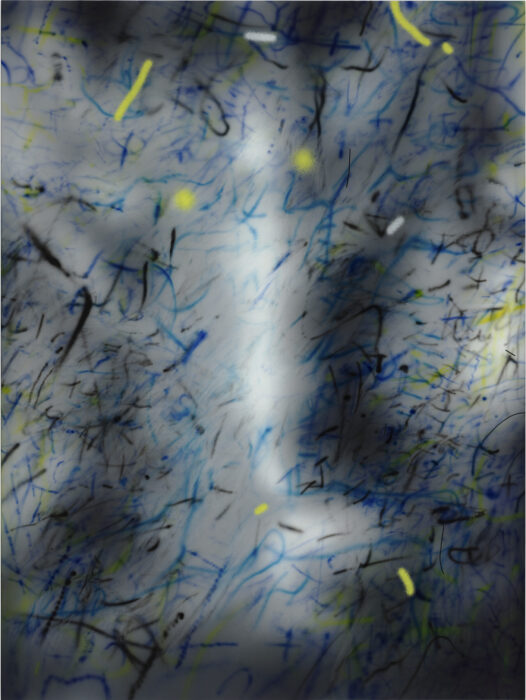 Around 2012, the echoes of the destruction caused by the war—Saddam Hussein’s building-bunker in Baghdad bombed by the US army—had gradually invaded the artist’s canvases with a sombre veil. The human body appears furtively in the form of ghostly, schematic footprints, representing that “resistance can take the form of a hand raised in protest, an erogenous zone that brings pleasure or an eye that bears witness” says Glenn Ligon, artist and friend of Julie Mehretu. Freed from the architectural drawings, the graphic signs become more gestural and nervous and seem to capture the complex energies emanating from the world, in the wake of the Arab Spring uprisings and the beginning of the revolution in Syria. However, in the restlessness and ambivalence of the signs and in the darkness of the canvases, we can easily perceive the shape of infinite possibilities, an opening towards a suspended future.
Around 2012, the echoes of the destruction caused by the war—Saddam Hussein’s building-bunker in Baghdad bombed by the US army—had gradually invaded the artist’s canvases with a sombre veil. The human body appears furtively in the form of ghostly, schematic footprints, representing that “resistance can take the form of a hand raised in protest, an erogenous zone that brings pleasure or an eye that bears witness” says Glenn Ligon, artist and friend of Julie Mehretu. Freed from the architectural drawings, the graphic signs become more gestural and nervous and seem to capture the complex energies emanating from the world, in the wake of the Arab Spring uprisings and the beginning of the revolution in Syria. However, in the restlessness and ambivalence of the signs and in the darkness of the canvases, we can easily perceive the shape of infinite possibilities, an opening towards a suspended future.
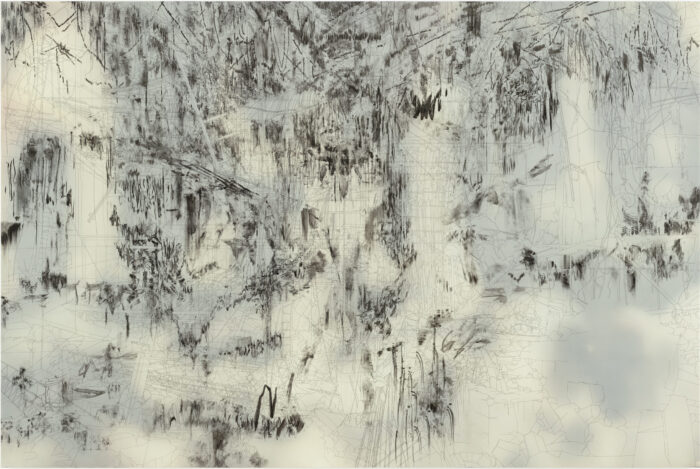
Since the mid-2010s, the background of Julie Mehretu’s canvases begins to be populated with evanescent, colorful shapes obtained by digitally modifying photographs—with their power to unexpectedly resurface in memory—taken from the news, most of which are widely circulated online and have become emblematic of the events they capture. The information they contain, the event mediated by the image and experienced from a distance, is no longer legible. The interest goes specifically to images of the rise of authoritarianism and white supremacism, the ferocity of civil wars and ethnic conflicts, catastrophic meteorological events (violent hurricanes, gigantic forest fires, etc.) or to emancipation movements and recent popular demonstrations and uprisings (in Lebanon, Catalonia and the Black Lives Matter movement in the United States), which often have in common the vulnerability of human beings to violence, but also their formidable power of resistance. The artist also dedicates many paintings to key figures in African American culture, a way of celebrating their cultural heritage and paying tribute. Other canvases do not refer to contemporary events, but to paintings dating back a few centuries that contains messages of hope and revelation. These canvases unleash a more explosive and unstable energy: the alternation of opacity and transparency is more and more intense and decisive, with also the addition of stencils and silk-screen printing.
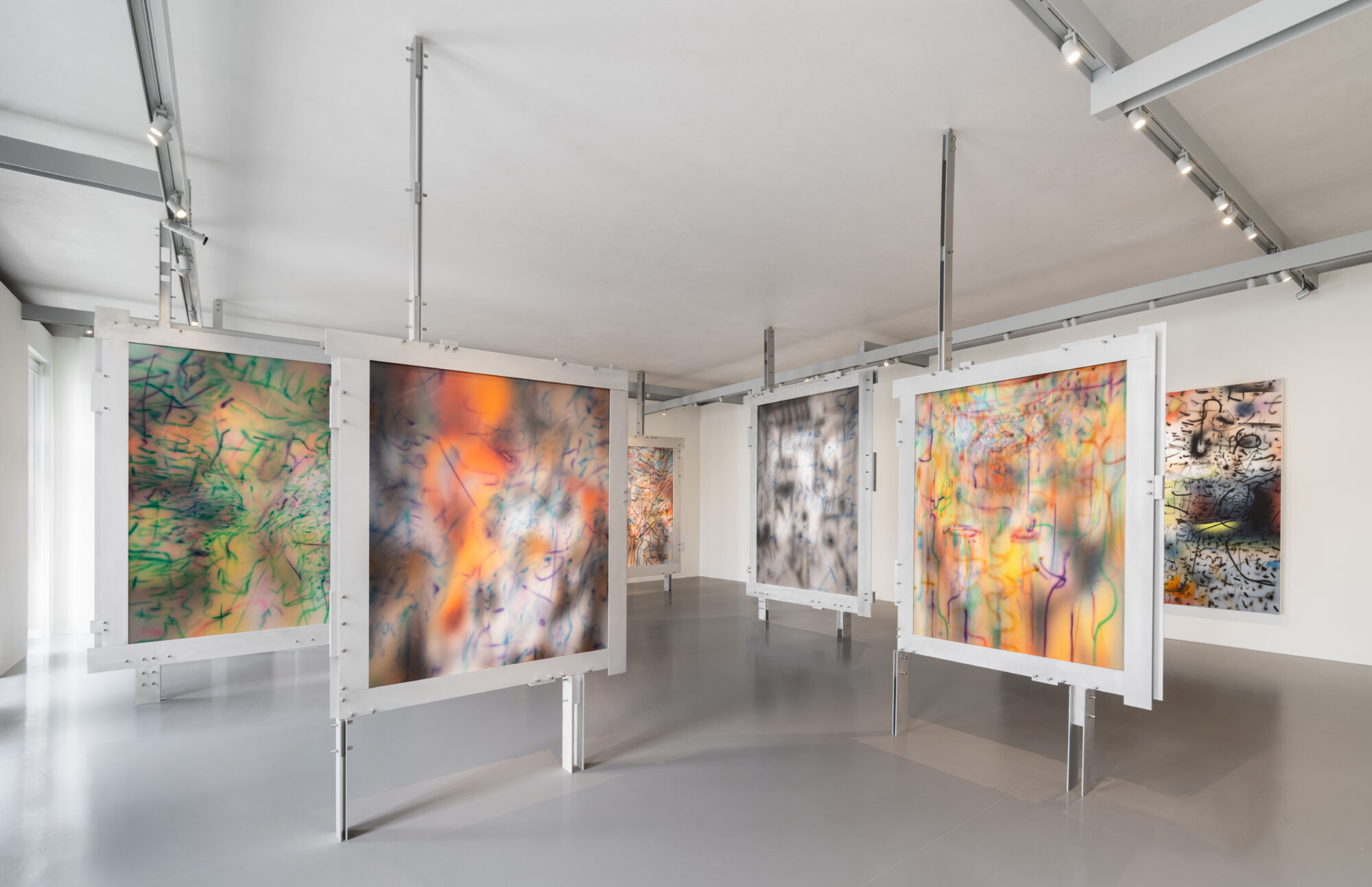
Continuing her exploration of original photographs transformed through digital manipulation, Julie Mehretu remains captivated by the evanescence and blurred focus inherent in the images. This fascination is complemented by her meticulous approach to transferring these marks onto canvas.
From the mid-1990s onward, engraving and printing techniques have become pivotal in Mehretu’s practice. Collaborating with skilled master printers, she employs complex processes to expand her color palette, enhance the complexity of image superimposition through lithographic transfers, and experiment with various methods of mark-making. These techniques afford Mehretu unprecedented control over ink application and visual appearance.
Around 2020, Mehretu adopts a more serial approach to painting, a shift underscored by the onset of the Coronavirus pandemic. Works from this period evoke moments of systemic disruption caused by catastrophic events such as devastating fires, pandemics, or revolutions. Within these compositions, the multitude of forms suggests both disorder and unity, reflecting on the collective responses to crisis.
In smaller-scale works, Mehretu continues her visual experimentation, employing diverse techniques including handwork, brushwork, airbrushing, and printmaking. Motifs and forms seem to migrate from one canvas to another, creating a dynamic interplay between works.
In her most recent series, created between 2021 and 2024, Mehretu delves further into the dystopian realities of the present. Drawing from photographs capturing traumatic events such as the storming of Capitol Hill by Donald Trump supporters in January 2022 and the invasion of Ukraine by Russian forces, these works explore themes of displacement and transition. Mehretu’s canvases become sites of reflection on the fluidity of identity and the enduring human capacity for resilience amidst upheaval.
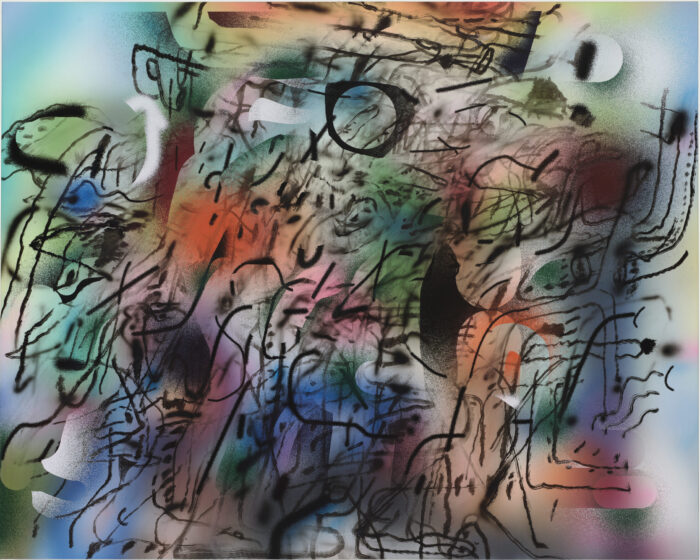
With the series of TRANSpaintings, the artist breaks new ground by liberating the paintings from the confines of the wall. Departing from traditional canvas, the support now comprises a slightly transparent polyester mesh, allowing light to permeate the surface intermittently and enabling viewers to glimpse the shadows of fellow visitors. This innovative approach reinforces a sense of ghostly human presence within the artwork. Embedded within sculptural supports crafted by artist Nairy Baghramian, which serve as both frame and structure, the TRANSpaintings blur the boundaries between painting and sculpture, inviting viewers to adopt a dynamic, mobile posture. Despite the gravity of the events depicted, the artist imbues the works with a sense of hope, expressing that “other light that can still emanate, is still possible”
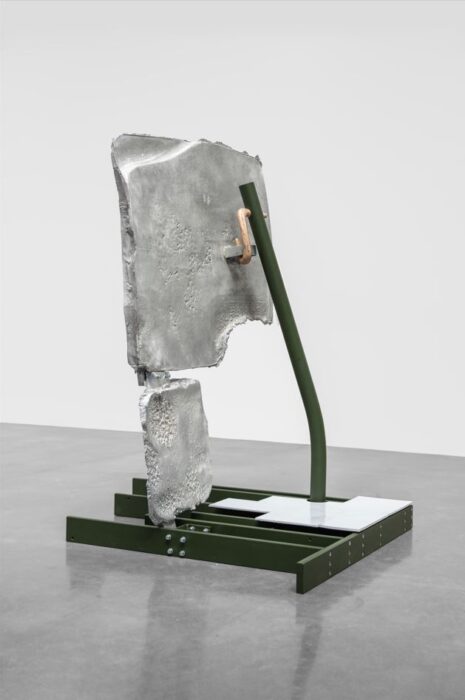 Employing an “ambitious abstraction,” as described by the artist herself, and utilizing materials such as steel, ceramics, aluminum, and silicon, Nairy Baghramian’s group of sculptures evokes the vulnerability of the human body through its raw and sober materiality, presenting a surface that is at times repelling and at others seductive.
Employing an “ambitious abstraction,” as described by the artist herself, and utilizing materials such as steel, ceramics, aluminum, and silicon, Nairy Baghramian’s group of sculptures evokes the vulnerability of the human body through its raw and sober materiality, presenting a surface that is at times repelling and at others seductive.
Huma Bhabha explores the intersection of science fiction, horror, modernist form, and archaic expression through sculpture. Enhanced by an intuitive and creative use of everyday materials such as cork, polystyrene, found objects, animal bones, clay, and bronze, her works convey a sense of timelessness. “The basic idea,” says the artist, “is that they are nomads, or on their way to somewhere, who knows where.”
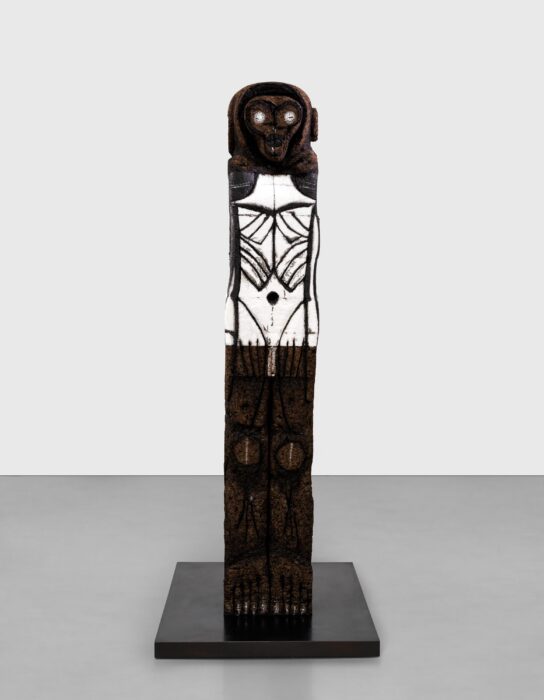 Since the mid-2000s, Tacita Dean has produced numerous portraits of fellow artists, all filmed in 16mm. By capturing moments of their subjects at work, in dialogue, or engaged in the apparent banality of everyday life, Dean eschews classical biographical narratives. Instead, she connects each artist to the materiality of their production and the subtle mechanics of their thinking. Additionally, two film works, revealing a more intimate side of Julie Mehretu—one at work, the other engaged in a freewheeling conversation with the Venezuelan-American artist Luchita Hurtado—serve as testament to the enduring intellectual partnership and unwavering friendship between Tacita Dean and Julie Mehretu.
Since the mid-2000s, Tacita Dean has produced numerous portraits of fellow artists, all filmed in 16mm. By capturing moments of their subjects at work, in dialogue, or engaged in the apparent banality of everyday life, Dean eschews classical biographical narratives. Instead, she connects each artist to the materiality of their production and the subtle mechanics of their thinking. Additionally, two film works, revealing a more intimate side of Julie Mehretu—one at work, the other engaged in a freewheeling conversation with the Venezuelan-American artist Luchita Hurtado—serve as testament to the enduring intellectual partnership and unwavering friendship between Tacita Dean and Julie Mehretu.
Cultivating a marginal position, David Hammons developed a fleeting and subversive oeuvre from the 1970s onwards, paving the way for an entire generation of African American artists. His practice encompasses assemblages, sculptures, and various devices, resulting in works imbued with a strong symbolic and poetic charge. As observed by Mehretu, “identity is something in constant transformation” within Hammons’s works, which also explore urban life and its contradictions. Though possessing an elegiac and mournful dimension, his works are also replete with provocation and irony.
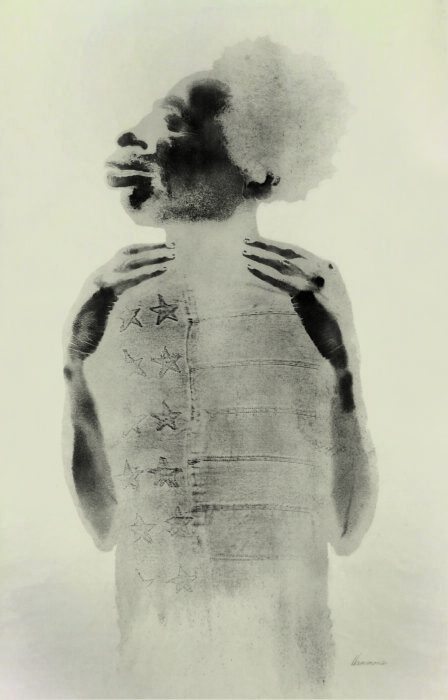 Robin Coste Lewis’s collection of photographs, borne out of the upheaval caused by the forced misplacement and dispersal of her family unit and its possessions, stands as a poignant testament to the simplicity, rarity, intimacy, and sheer existence of the vernacular ensemble. However, Lewis infuses a darker undercurrent of nostalgia, juxtaposing an original soundtrack that situates African diasporic migrations within the broader context of human history and evolution. The evocative and disarming reading of a lyrical poem, dedicated to Julie Mehretu and interspersed with prolonged silent sequences, serves as a tribute to the millennia-long diasporas of all humanity, with Afro-descendants occupying a central role in these narratives of migration.
Robin Coste Lewis’s collection of photographs, borne out of the upheaval caused by the forced misplacement and dispersal of her family unit and its possessions, stands as a poignant testament to the simplicity, rarity, intimacy, and sheer existence of the vernacular ensemble. However, Lewis infuses a darker undercurrent of nostalgia, juxtaposing an original soundtrack that situates African diasporic migrations within the broader context of human history and evolution. The evocative and disarming reading of a lyrical poem, dedicated to Julie Mehretu and interspersed with prolonged silent sequences, serves as a tribute to the millennia-long diasporas of all humanity, with Afro-descendants occupying a central role in these narratives of migration.
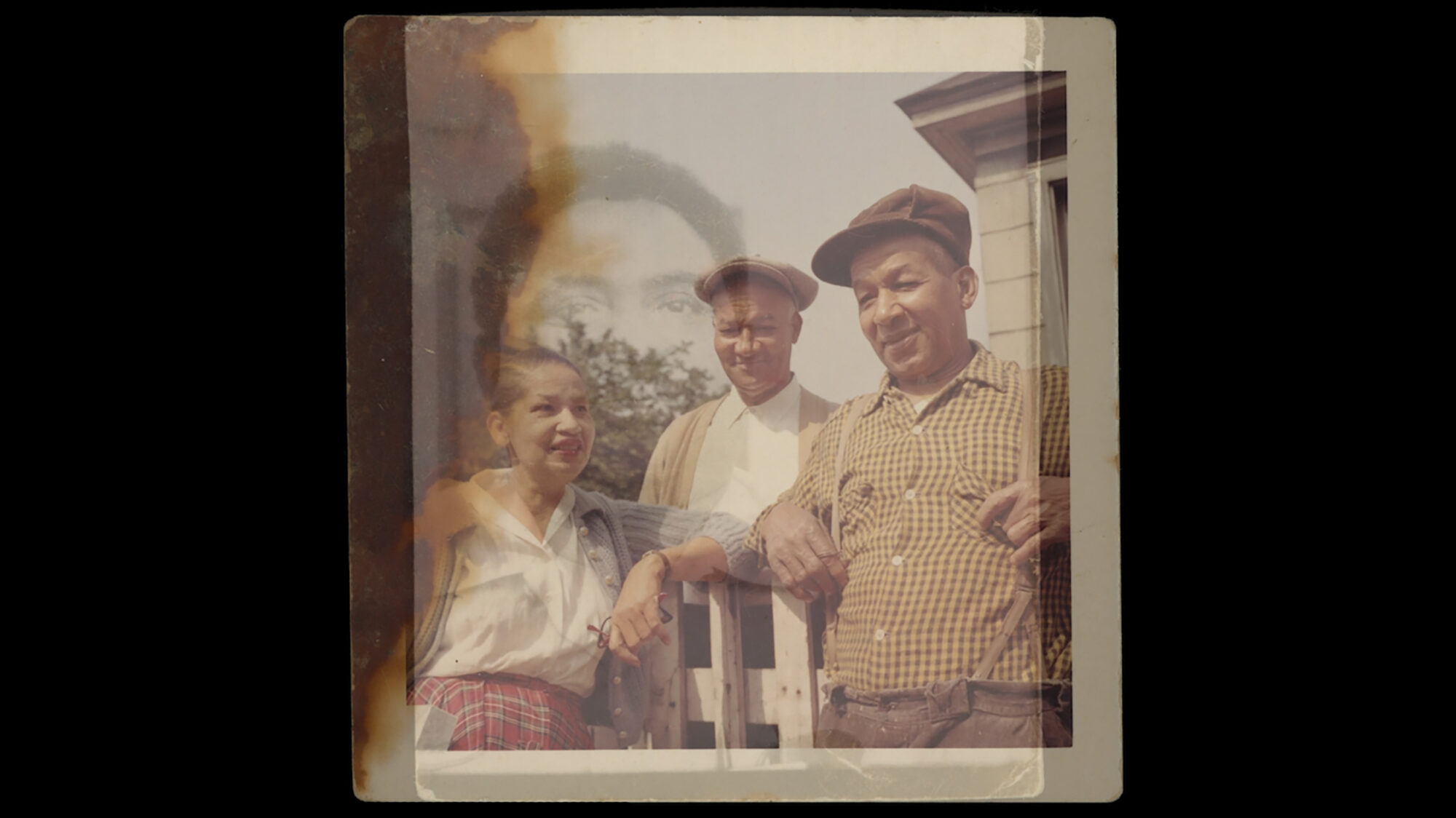 Paul Pfeiffer’s series of hyper-realistic sculptures depicting the body parts of singer Justin Bieber encapsulate the essence of the absolute pop star, whose image has symbolized eternal adolescence since his discovery by the music industry at the tender age of twelve. These slender, dismembered body parts, adorned with tattoos spanning from collarbones to wrists, evoke the relics of a young saint or Christ, presented for devout reverence. Drawing inspiration from the practice of encarnadores, which originated in 16th-century Seville before being introduced to the Philippines by Spanish missionaries, Pfeiffer’s sculptures echo the objects of great devotion that still populate the churches of the Philippines, home to the largest Christian population in Asia—a milieu in which Pfeiffer himself was raised. Through his sculptures, the artist confronts our fascination with various forms of ‘holiness’ throughout history, unmasking their hidden psychological effects and revealing their role in the evolution of consciousness. Additionally, alongside Mehretu, Paul Pfeiffer is one of the co-founders of Denniston Hill, a residency program facilitating meaningful discussions among artists on topics such as the history of modernity, diaspora, and exodus.
Paul Pfeiffer’s series of hyper-realistic sculptures depicting the body parts of singer Justin Bieber encapsulate the essence of the absolute pop star, whose image has symbolized eternal adolescence since his discovery by the music industry at the tender age of twelve. These slender, dismembered body parts, adorned with tattoos spanning from collarbones to wrists, evoke the relics of a young saint or Christ, presented for devout reverence. Drawing inspiration from the practice of encarnadores, which originated in 16th-century Seville before being introduced to the Philippines by Spanish missionaries, Pfeiffer’s sculptures echo the objects of great devotion that still populate the churches of the Philippines, home to the largest Christian population in Asia—a milieu in which Pfeiffer himself was raised. Through his sculptures, the artist confronts our fascination with various forms of ‘holiness’ throughout history, unmasking their hidden psychological effects and revealing their role in the evolution of consciousness. Additionally, alongside Mehretu, Paul Pfeiffer is one of the co-founders of Denniston Hill, a residency program facilitating meaningful discussions among artists on topics such as the history of modernity, diaspora, and exodus.
 Jessica Rankin’s work, employing tools traditionally associated with women’s activities such as embroidery and needlework, manifests as ‘mental landscapes.’ Through delicate yet ghostly textile compositions, the artist delves into the personal relationships that tether her to her environment. These layered works, adorned with coded symbols and constellations, function as psycho-geographic maps, revealing the intricate interplay between individual experience and collective consciousness. Writing occupies a pivotal role in Rankin’s practice, with her creative process often stemming from the act of inscribing words onto paper, drawn from her stream of consciousness or fragments of texts by marginalized voices in literature. Since 2016, Rankin has embraced gestural abstract painting, intertwining it with embroidery to create works where paint and thread harmonize, echoing and refracting each other’s forms.
Jessica Rankin’s work, employing tools traditionally associated with women’s activities such as embroidery and needlework, manifests as ‘mental landscapes.’ Through delicate yet ghostly textile compositions, the artist delves into the personal relationships that tether her to her environment. These layered works, adorned with coded symbols and constellations, function as psycho-geographic maps, revealing the intricate interplay between individual experience and collective consciousness. Writing occupies a pivotal role in Rankin’s practice, with her creative process often stemming from the act of inscribing words onto paper, drawn from her stream of consciousness or fragments of texts by marginalized voices in literature. Since 2016, Rankin has embraced gestural abstract painting, intertwining it with embroidery to create works where paint and thread harmonize, echoing and refracting each other’s forms.
“Ensemble” transcends conventional boundaries of artistic expression, beckoning viewers into a symphony of ideas and emotions. Mehretu’s ambitious abstraction acts as a catalyst for introspection, prompting us to grapple with the intricacies of our world and envision new avenues for collective action and rejuvenation. As we traverse the exhibition, we are reminded of the transformative power of collaboration and connection in shaping our understanding of identity, history, and the human condition.
